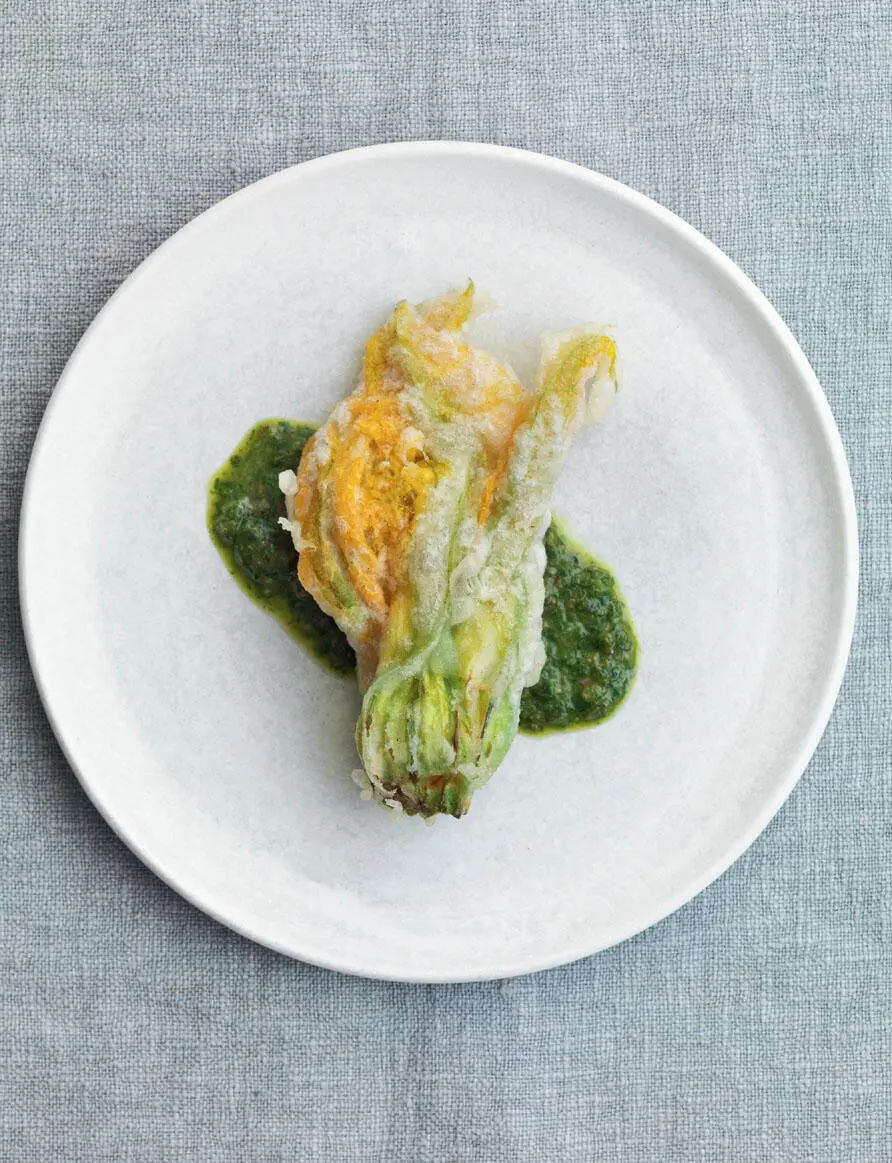50g flaked toasted almonds
3 tbsp olive oil
½ tsp sweet smoked paprika
2 tbsp chopped flat-leaf parsley
2 tsp tomato purée
splash of dry sherry
sea salt and freshly ground black pepper
To make the romesco sauce, place all of the ingredients in a food processor and pulse until you have a chunky paste. Season with sea salt and black pepper. Divide between four plates.
Heat a dry grill pan over high heat until smoking. Drizzle the padron peppers with a little oil and seasoning, then grill for about 5 minutes until lightly blackened.
If using small burrata balls, tear them over the romesco. If you’re using larger burrata, cut them almost all the way through then peel open and add half a burrata per portion, cut side facing up, to the romesco. Drizzle with olive oil and season well. Garnish with the grilled padron peppers and serve immediately.

HONEY-BAKED FETA WITH LAVENDER, THYME AND RYE CRISPS
A great alternative to a traditional cheese board, this baked feta combines salty cheese with fragrant, lightly caramelised honey. Serve with these crisp rye bread crackers, crusty bread or your favourite cheese biscuits. I love the fragrant lavender in this dish – it really adds a point of difference.
Serves: 4
Preparation time: 10 minutes, plus 1 hour draining
Cooking time: 12–20 minutes
1 × 200g block feta cheese
½ loaf rye bread
4 tbsp olive oil
1 garlic clove, halved
3–4 tbsp runny honey
4 sprigs of thyme
2 sprigs of fresh lavender or ½ tsp dried lavender
sea salt and freshly ground black pepper
Preheat the oven to 200°C/180°C fan/gas 6.
Cover the feta with 2 pieces of kitchen paper and leave at room temperature for 1 hour to absorb excess moisture.
Cut the rye bread into very thin slices. Place them in a single layer on 2 baking trays. Drizzle with the olive oil and rub each slice with a halved garlic clove.
Bake the rye slices in the oven for 7–10 minutes until lightly golden and crisp. Remove the rye crisps and turn the oven to its grill setting.
Remove the kitchen paper from the feta and place the feta in an ovenproof dish just large enough for it to fit in snugly. Drizzle the honey on top, then add the thyme and lavender. Season well with sea salt and pepper and grill for 5–10 minutes until golden.
Remove the cheese from the grill. Serve the feta immediately with the rye crisps.

COURGETTE FLOWERS WITH RICOTTA AND SWEET BASIL SAUCE
Courgette flowers are another of those wondrous ingredients that signal the arrival of warmer weather. Not much needs doing to them as they are perfect simply fried in a little oil and served with this sauce. Choose the flowers that are large and firm, as they can accommodate more stuffing and will retain their shape better when cooked.
Serves: 4 as a starter
100g ricotta cheese
grated zest of ½ lemon
4 courgette flowers
vegetable oil, for deep-frying
sea salt and freshly ground black pepper
FOR THE TEMPURA BATTER
6 tbsp cornflour
3 tbsp plain flour, plus extra for dusting
3–6 tbsp soda water
FOR THE SWEET BASIL SAUCE
1 bunch of basil, leaves only
juice of 1 lemon
4 tbsp olive oil
1 tbsp drained, chopped capers in brine
1 tbsp runny honey
Mix the ricotta with the lemon zest and season with sea salt and pepper to taste. Fill each courgette flower with the mix and chill while you make the batter (you can stuff them up to 2 hours ahead of time, if you wish).
To make the tempura batter, mix the cornflour and flour together in a bowl. Gradually whisk in enough of the soda water to make a thick batter. Season with a pinch of sea salt.
To make the sweet basil sauce, place all the ingredients in a small food processor and blend until smooth.
To fry the flowers, pour enough vegetable oil in a deep-fat fryer or large, deep saucepan to come up to 4–6cm and heat it to 180°C.
Dust two of the courgette flowers in flour, dip them in the batter, then carefully place them in the hot oil. Fry for 4–6 minutes until deep golden and crisp. Remove each flower with a large slotted spoon and transfer to kitchen paper to remove any excess oil, then season with sea salt if needed. Repeat with the remaining two flowers.
Serve immediately with the basil sauce.

SALT-BAKING
As a chef, and for any home cook, salt can transform a dish from bland to flavoursome.
I prefer to create a salt dough, rather than use a crust of salt alone, as you can add different ingredients to the dough which then impart even more flavour to the food it encloses. The flour in the dough also lessens the intensity of the salt, enabling more control over the seasoning. Salt-baking works in two ways: firstly, the dough creates a shell for the food, trapping in the heat during cooking so the juices are retained and the food is steamed within the crust. Secondly, it seasons the food while it’s cooking, with the salt permeating throughout. Traditionally salt-baking has been used to cook meat, fish and poultry (and you’ll find a Salt-baked Shoulder of Lamb). I’m focusing here on salt-baked vegetables to highlight what a brilliant technique it is for bringing out their wonderful flavour.
For salt-baking, rock salt is the only salt to use. Unlike sea salt and table salt, it retains its texture, so the food you are cooking will not be over-seasoned. I mix the salt with plain white flour (which can easily be substituted with gluten-free flour for coeliacs), adding herbs and – sometimes – spices before binding the dough ingredients together with water.
A good way to check if the food within the salt-dough shell is cooked is to use a metal skewer and insert it into the centre. Using this method to test for doneness means you can tell how soft vegetables are, and also how warm the centre of meat joints are, by holding the end of the skewer that has just been inserted on the inside of your wrist to gauge the temperature.
Once the item is baked, do not leave the salt dough on for too long as the salt will continue to permeate through it and it can become over-seasoned.
SALT DOUGH
Mix the ingredients together and bind with 100ml cold water to form a dough. Roll out the dough on a sheet of baking parchment to a thickness of 2mm, then wrap it around the vegetable or joint of meat until it is completely enclosed. Place the dough-wrapped ingredient on the lined baking sheet and bake for the time given in the recipe.
100g rock salt
200g plain flour
chopped herbs of choice
| INGREDIENT |
SALT-DOUGH QUANTITY |
HERBS/SPICES |
| Root vegetables |
1 quantity |
Lavender, nutmeg, thyme, rosemary, bay leaves |
| Whole fish |
1 quantity |
Dill, thyme, rosemary, bay leaves, lavender, basil, lemongrass |
| Whole poultry |
2 quantities |
Tarragon, thyme, rosemary, oregano, bay leaves |
| Joints of meat |
2 quantities |
Lavender, thyme, rosemary, bay leaves |

SALT-BAKED PARSNIP AND HORSERADISH CRUMBLE
Читать дальше
















